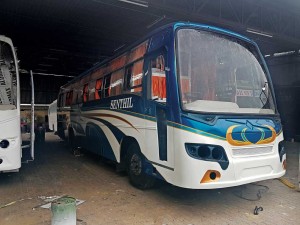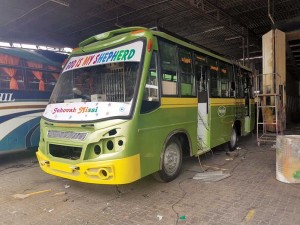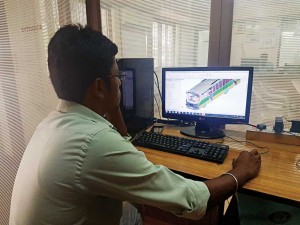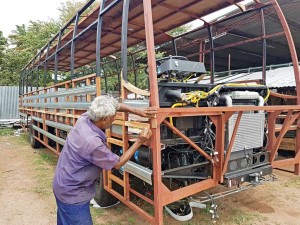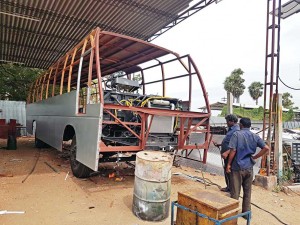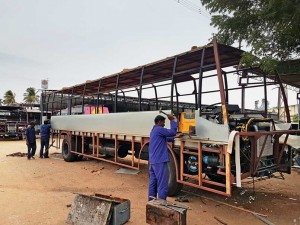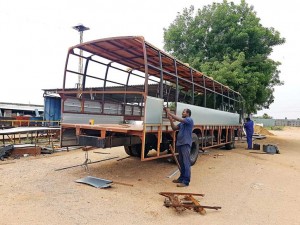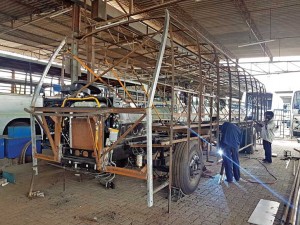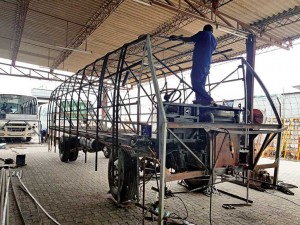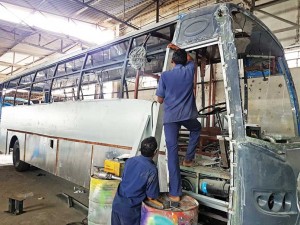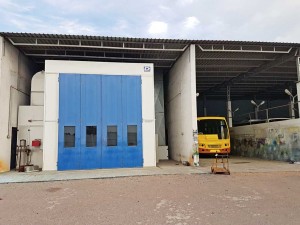Karur’s bus industry is determined to succeed in the face of challenges. Story by:
Bhargav TS
Heraclitus, a Greek philosopher, is quoted to have said that ‘change is the only constant in life.’ In case of the bus body building industry of Karur this has been proved right, time and again. Located 371 km to the south west of Chennai, the city’s bus industry has kept up with the changing times. It has displayed much determination in building buses. Tracing its origin to the establishment of L G Balakrishnan & Bros (LGB) in 1956 by G Balakrishnan, the bus industry of Karur has kept growing. Organising itself under the Karur Bus Body Builders Association, and affiliated to the Association of Tamil Nadu Coaach Builders, many bus body builders in the city came into existence in the 1980s. Home to over 50 bus body building enterprises, Karur’s bus industry is estimated to be around Rs.1000 crore per annum. According to P Palani Samy, President, The Association of Tamil Nadu Coaach Builders, over 4000 coaches are manufactured at Karur every year. This number, he mentions, is slated to rise past 7,500 units once the cluster comes into play. The cluster, Karur Bus Body Builders Cluster Private Limited, was incorporated in 2008 as a private entity, and is expected to be operational soon.
Bus body code accreditation
Credited with building most buses in South India, the bus industry of Karur, a part of India’s humongous SME sector, which has received encouragement from the government from time to time for its ability to provide industrial employment to the people of the country and produce indigenously, is facing the toughest challenge in its history almost. The implementation of the Bus Code (AIS052) by the Government of India has put a big question mark on the industry’s ways of functioning. Aimed at streamlining the bus body building industry, and enhancing the safety of buses, according to an industry expert, the Bus Code has made it mandatory for the bus body builders at Karur to obtain an accreditation certificate from Pune-based Automotive Research Association of India (ARAI) and Central Institute of Road Transport (CIRT).
Bus Code was formulated in 2001 as the ‘Code of Practice for Bus Body Design and Approval’ by a technical committee set up by the Ministry of Shipping, Road Transport and Highways (MoSRT&H) in response to the fact that bus body builders were building bodies on drive-away chassis of poor design, and by using poor quality products. There was found to be no uniformity of construction. The (bus) body structures were thus hardly design optimal and safe; the cabin and seats were cramped, and the people were subjected to extreme heat, vibration, noise, poor comfort and protection. Bus Code accreditation by a bus body builder, it was highlighted, would confirm his ability to adhere to the safety norms prescribed.
The Bus Code implementation for April 01, 2015, was announced in December 2014. The deadline to implement the Bus Code was however extended by six months to August 01. 2015, so that those bus body builders who could not meet it were able to do so. The dimensions implementation took place in April 2016. A regulation is known to have been issued recently that, the bus code will be issued in total on October 01, 2016. According to industry experts, the Bus Code enhances safety features of medium and high capacity buses (Type I), buses for inter-urban transport (Type II), long-distance passenger transport (Type III) and special purpose vehicles — school buses and tourist buses (Type IV). Separate specifications have been provided for non-deluxe, semi-deluxe, deluxe, air-conditioned deluxe buses that come under all four types.
The challenge
The idea behind the formation of a cluster by the bus body builders of Karur was to create a Common Facility Center (CFC) with a capital outlay of Rs. 9.5 crores. The central government would fund 70 per cent, and the state would fund 15 per cent. The rest of the amount (15 per cent) would be funded by the bus body builders as members. The cluster would require a minimum of 20 members to start with. Claims a Karur bus industry source that more than 20 member have been signed till date. He mentions that with the bus body builders here specialising in building stage carriers for private operators and government transport undertakings prominently, the formation of cluster was thought to be of much use to grow further. States another industry source under the condition of not disclosing his identity, that the situation over the last one year has changed drastically. Hopes of growth are lost, and there’s a growing fear if the industry will survive.
Stating that the bus code’s emphasis on safety is fine, an industry insider at Karur avers, the buses that have been built here are stronger and last longer than branded buses. He draws attention to significant orders for MTC in Chennai for semi-low floor buses executed recently by Karur’s bus industry. He also draws attention to orders executed for key private operators like SRS Travels and Parveen Travels. Expresses Palani Samy, “We are very concerned about passenger safety. Data from the studies on road accidents indicate that the coaches made by the Karur bus body builders are of high standards. Those that met with accidents, it was revealed, did not suffer structural failure. Even the roll-over protection standard was met. We use high quality materials is beyond doubt.”
According to Soundararajan, Director, Maaruthi Coach Builders, most bus body builders at Karur are in the business for more than 30 years. “We have come to learn of the customer’s mindset. Spread as far as Orissa and Andaman & Nicobar Islands, they rely on us for the quality we offer. We are however facing a serious threat. Despite making coaches according to the standards we have been asked to follow the Bus Code, which calls for several design changes. Each part, may it be the seats, electricals, steel channels, and the floor materials, need to be certified. The structure design requires roll over protection. The governing body asked us to prepare a bus that meets all the requirements on behalf of the association. We did it. After spending huge amount of money, they have asked us, each bus body builder, to prepare a bus for validation,” he adds. The challenge, it is clear, is about each bus body builder applying for an accreditation. No cluster or association is entertained, claims an industry source.
The solution
The attempt to build a bus for bus code accreditation as an association has left the bus body builders of Karur wounded. They feel that their effort to build a bus by forming an association has been a waste. Avers Soundararajan, that such tantalising decisions are costing them dear. “Small players like us are the most affected,” he adds. To abide with the new (Bus Code) standards, Maaruthi Coach Builders has begun working towards developing a bus that will meet the requisite standards. States Soundararajan, “To meet the challenge, we feel the need to become a fully integrated bus maker. The task of building a chassis and a bus will allow us to be competitive. The threat here is from the chassis manufacturers. The government has to step in. It has to make the necessary changes in the regulation. We would otherwise be shutting down our facilities.”
In Karur, 13 bus body builders are known to have secured the accreditation. Many more are on their way to get it. Interestingly, avers an industry source, even STUs must get accreditation. The design aspect of the coach must be validated by the certifying agencies, and only then can a bus or a coach be registered. Mentions a Karur coach builder, that component makers can produce standardised material with the uniform code. This will lead to better efficiency and competent after-sales service. “Most significantly, it will help us to provide comfortable and safe buses which will not only delight passengers but also help to decongest roads and lead to a greener environment,” he adds. He draws attention to the fact that the buses built by Karur coach builders are stronger and last longer than branded buses.
Addressing sleeper coach demand
Demand for sleeper coaches in India is on the rise. Many bus body builders are responding to this demand. Claims an industry insider at Karur, that sleeper coaches are classified as special purpose buses. They are designed and constructed to let the passengers sleep, he adds. Sleeper coaches are claimed to be placed in the category “Type IV” as per the Bus Code. Opines Soundararajan, “In the case of sleeper buses, we are already following the code. According to the standards we provide the window panes with a sliding movement. We provide separate windows on sides of the bus for upper and lower berths. In sleeper coaches, the berth structures are welded, bolted or interlocked by suitable means so that there won’t be any rattling or dislodging of berths.” Aware of the growing response for sleeper coaches in Tamil Nadu, is Soundararajan informs that they are unable to satisfy the demand. It is because the sleeper coaches at Karur are built to high standards, he adds.
Pointing at the changing requirements of clients, Soundararajan avers that the bus industry is not what it was before. He expresses that another round of change at Karur has begun. Much of this is in part of the requirement to achieve bus code accreditation, he points out. Many bus body builders at Karur are investing in CAD facilities for design and engineering requirements. To develop a bus body design, informs a Karur bus body building company owner, CAD images and various chassis details are required from the respective manufacturers; the same have to be integrated and checked for roll-over protection. The need to buy a design software is adding to the cost of operation. Without getting a design approval, it is not possible to produce. Mentions Soundararajan, “In order to meet the roll-over protection standards we are working on an entirely new design of bus bodies. We are doing so because we do not want our bodies to have any scope for failure.” “The roll-over protection is one of the most important clauses which will rewrite the entire design of bus bodies,” he avers.
The Bus Code is looking like the toughest test the bus body builders of Karur have faced until now. Not to give up, they are investing in the requisite software and other requirements necessary. In an environment where the odds seem to stacked against them, it is clear that not all bus body builders are on the same page. Some are better positioned to invest and upgrade, others are not. Their attempt as an association to get Bus Code accreditation has failed, but their hope for a better tomorrow continues to drive them. If their expectation of government help sounds logical, their ability to keep changing with the times will see them in good stead. The new buses rolling out of Karur are certain to be even better.



